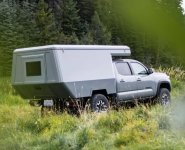Leighsjor
Active member
With the first plug fully prepped for mold making we prepared ourselves for a big, nasty fiberglass job. Up to this point I had only experimented with smaller fiberglass molds so this size of mold was definitely a daunting project to take on.
In the first photo you see the plug after getting sprayed with black tooling gelcoat and in the second you see the progress of adding layers of chop strand mat wet with resin. This was a very meticulous process as you have to roll any little air bubbles out of the wet fiberglass and then wait for specific cure times between layers. I recruited the help of my good friend Isaac for the process of mixing resin and wetting out the glass. It was definitely at least a two person job for this big of a part.
Under some of the final layers I decided to add some ribbing to ensure the larger flat surfaces of the mold don't deflect as I use the mold.
Here's a short video walk around after finishing the last layers of fiberglass. At this point Isaac and I had worked until after 3 am, but we woke up early the next morning eager to demold and see the results!
And here's a video of the results! Can you feel our excitement after pulling the plug from the mold?
After pulling the plug we cleaned up the mold and trimmed the edges.
And there you have it, one camper mold ready to use! ...Now for the other side...
In the first photo you see the plug after getting sprayed with black tooling gelcoat and in the second you see the progress of adding layers of chop strand mat wet with resin. This was a very meticulous process as you have to roll any little air bubbles out of the wet fiberglass and then wait for specific cure times between layers. I recruited the help of my good friend Isaac for the process of mixing resin and wetting out the glass. It was definitely at least a two person job for this big of a part.
Under some of the final layers I decided to add some ribbing to ensure the larger flat surfaces of the mold don't deflect as I use the mold.
Here's a short video walk around after finishing the last layers of fiberglass. At this point Isaac and I had worked until after 3 am, but we woke up early the next morning eager to demold and see the results!
And here's a video of the results! Can you feel our excitement after pulling the plug from the mold?
After pulling the plug we cleaned up the mold and trimmed the edges.
And there you have it, one camper mold ready to use! ...Now for the other side...

















